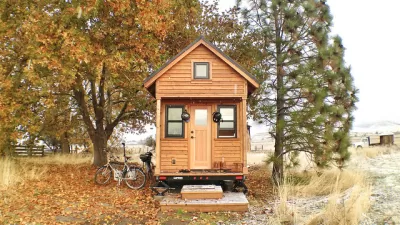Building sizes have been creeping upward for centuries, but green building expert Jason McLennan argues that smaller structures are better, more beautiful, and ecologically inevitable.
Throughout history, empires have been scaling up their building sizes in order to reflect their power. In modern times, we build oversize buildings to match our oversize corporations, "mega-metropolises," and economies.
But Jason McLennan argues that this can't go on forever. "There is a point where individual accountability, familiarity, and sense of place disappear. And we have reached it," he writes. "We have lost the ability to relate to and understand our food systems, economic systems, energy and transportation systems, and ultimately the environment itself."
McLennan believes that we'll necessarily return to a sustainable scale of building and living within the next 20 years. He predicts that our skyscrapers will shrink, we'll start to live more locally, and start learning to know the land and communities again. "The only oversized movement we need is the one that takes us closer to small, localized solutions."
There's no single right size for buildings or communities, he says, but the key is to find the "sweet spot" for any initiative and he includes a number of tests of scale for identifying it.
FULL STORY: In the Built Environment, the Tyranny of the Big, the Beauty of the Small

Alabama: Trump Terminates Settlements for Black Communities Harmed By Raw Sewage
Trump deemed the landmark civil rights agreement “illegal DEI and environmental justice policy.”

Planetizen Federal Action Tracker
A weekly monitor of how Trump’s orders and actions are impacting planners and planning in America.

The 120 Year Old Tiny Home Villages That Sheltered San Francisco’s Earthquake Refugees
More than a century ago, San Francisco mobilized to house thousands of residents displaced by the 1906 earthquake. Could their strategy offer a model for the present?

Indy Neighborhood Group Builds Temporary Multi-Use Path
Community members, aided in part by funding from the city, repurposed a vehicle lane to create a protected bike and pedestrian path for the summer season.

Congestion Pricing Drops Holland Tunnel Delays by 65 Percent
New York City’s contentious tolling program has yielded improved traffic and roughly $100 million in revenue for the MTA.

In Both Crashes and Crime, Public Transportation is Far Safer than Driving
Contrary to popular assumptions, public transportation has far lower crash and crime rates than automobile travel. For safer communities, improve and encourage transit travel.
Urban Design for Planners 1: Software Tools
This six-course series explores essential urban design concepts using open source software and equips planners with the tools they need to participate fully in the urban design process.
Planning for Universal Design
Learn the tools for implementing Universal Design in planning regulations.
Clanton & Associates, Inc.
Jessamine County Fiscal Court
Institute for Housing and Urban Development Studies (IHS)
City of Grandview
Harvard GSD Executive Education
Toledo-Lucas County Plan Commissions
Salt Lake City
NYU Wagner Graduate School of Public Service



























